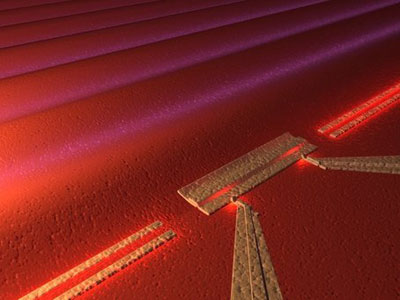
Physicists are very good at making measurements with single photons of light. Soon, however, they may also be doing routine studies of single phonons – single quanta of sound. That is the claim of physicists in Sweden and Germany, who say they have detected acoustic waves that are so weak they are – almost – at the quantum limit.
Recent years have seen a great effort to work with mechanical oscillations in the quantum regime. In such a regime, a mechanical device would be able to both emit and detect single phonons – just as optoelectronic devices are already able to emit and detect single photons. In 2010 a group at the University of California, Santa Barbara, US, demonstrated that it could create single phonons using a cryogenically cooled mechanical oscillator, thereby taking the first step on the quantum road.
Approaching the quantum limit
Now, Martin Gustafsson of Chalmers University of Technology in Sweden and colleagues have studied the echoes of near-quantum-limited acoustic waves, using a device they call a quantum microphone. In contrast to the Santa Barbara group’s mechanical oscillations, acoustic waves are propagating waves that travel over a surface, like ripples spreading in water. These particular acoustic waves are not quantum mechanical in behaviour, although they are almost weak enough to be at the quantum limit. “You could say that we have shown the way to quantum acoustics, and I think others would agree that this is a very exciting prospect,” says Gustafsson.
The experiment consists of a long, thin chip of the semiconductor gallium arsenide, at the ends of which are transducers that generate acoustic waves. Gallium arsenide is piezoelectric, so any deformations of its structure caused by the acoustic waves generate changes in electric polarization. This polarization, a subtle movement of electrons, is detected by a single-electron transistor – the quantum microphone – which sits midway along the gallium-arsenide chip. The entire apparatus is cooled to 200 mK.
Test for echo
Gustafsson and colleagues at Chalmers and the Paul Drude Institute in Berlin used one of the transducers to generate acoustic waves at a frequency of 932 MHz. These waves travel to the other end of the chip, then bounce back again. Indeed, the waves echo back and forth several times, all the while shifting electrons through the transistor. Using this electron movement as a proxy, and averaging over millions of experimental runs, the transistor is effectively able to detect acoustic waves at the single-phonon level, claim the researchers. The amplitude of the wave is just a few per cent of the diameter of a proton.
Konrad Lehnert, an expert in the quantum behaviour of electromechanical circuits at the University of Colorado at Boulder, US, believes the work has potential. But he thinks studies of true quantum acoustics are still some way off. “The claim of single-phonon sensitivity is frankly overblown,” he says. “To say that one can detect single phonons after averaging is to say that one cannot detect single phonons.”
Coupling qubits
Gustafsson agrees that his group’s experiment is still firmly in the classical regime. For one, he says, the researchers must average the signal from millions of acoustic waves to exclude noise, and every wavepacket itself often contains not one but several phonons – most of the wavepacket passes alongside the transistor undetected. Still, his group has ideas for generating acoustic phonons, by using a superconducting “qubit” to couple to the waves via charge movement, which is similar to how the transistor operates.
“We compare such an experiment with experiments that have been done very recently with single microwave photons, and find that it should be feasible to do acoustic versions of those,” says Gustafsson.
The research is described in Nature Physics.



